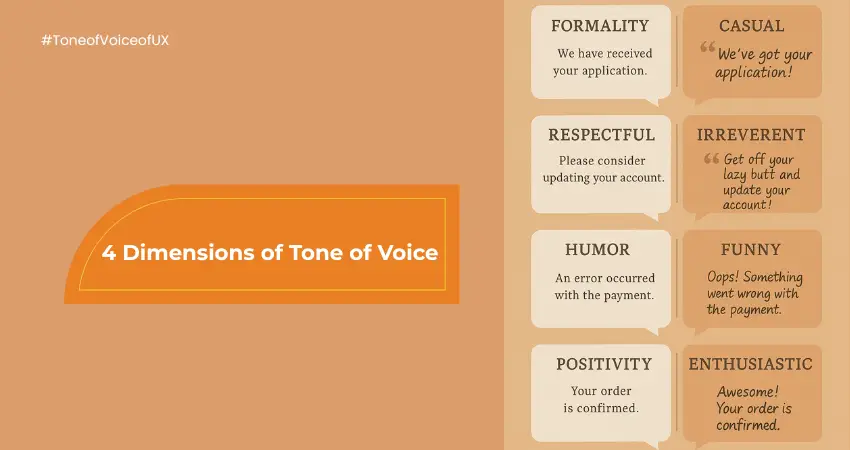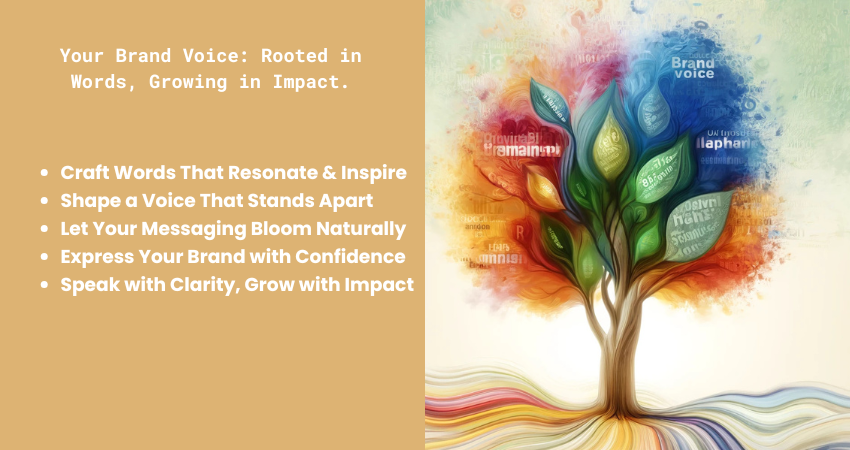Understanding Tone of Voice in UX Writing: The 4 Dimensions Every Writer Needs to Master

Tone of voice in UX writing is more than just personality—it’s a powerful UX design principle that influences user trust, clarity, and connection. And in an online environment where users are constantly scanning and judging with limited attention spans, tone becomes the invisible bridge between design and human experience. Whether you’re writing a 404 error message, onboarding flow, or chatbot script, your tone of voice determines how the message lands—emotionally and cognitively. This article breaks down the four essential tone of voice dimensions—developed through usability research—and shows how content writers and UX professionals can use them to craft accessible, consistent, and compelling microcopy. Why Tone of Voice in UX Writing Isn’t Optional Anymore Tone of voice is often dismissed as something you sprinkle at the end of the content process. That’s a mistake. Here’s why it deserves a front-row seat in every UX writing strategy: It builds trust. A consistent and relatable tone builds credibility and emotional comfort. It reduces cognitive load. Familiar and human-centred language is easier to process, especially in high-stress moments like error handling or payments. It reflects brand integrity. Your product’s tone should echo your values. If you’re a brand that promotes simplicity and empowerment, your copy should too. It shapes user behavior. Tone can nudge users toward taking action or provide the reassurance they need to continue a task. Tone isn’t an overlay—it’s part of the UX architecture. The 4 Dimensions of Tone of Voice (and How to Use Them) The tone of your writing can be broken down into four sliders or spectrums. These allow teams to visualise, define, and apply voice in a more systemised way. 1. Formal vs Casual Formality sets the tone for how professional or conversational your writing feels. A formal tone is structured, respectful, and restrained. It minimises contractions and slang and is best suited for sensitive, legal, financial, or high-stakes content. A casual tone mirrors everyday speech. It uses contractions and informal phrases. This style humanises the interface and makes it approachable. Deeper Insight: A formal tone may signal authority but can also create distance. A casual tone feels warm but may lose precision. Balance based on the user journey stage. Tip for writers: If you’re writing across multiple touchpoints (e.g., FAQs, landing pages, chat support), define a tone range rather than a single point. Formal: “Your credentials have been verified.” Casual: “All set! You’re good to go.” 2. Funny vs Serious Humour in UX writing is powerful—but it’s not always welcome. A humorous tone introduces playfulness and charm. It’s ideal for light-hearted products, creative industries, or gamified user experiences. A serious tone is neutral, direct, and no-nonsense. It’s crucial during tasks that involve user stress, confusion, or critical data. Deeper Insight: Humour is cultural, contextual, and highly subjective. What works in a Gen Z fintech app may fall flat in an enterprise SaaS dashboard. Tip for writers: Always user-test humour. One misplaced joke can erode brand trust more than a typo. Funny: “Oops! We messed up. We’re fixing it faster than you can say ‘debug’.” Serious: “An unexpected error occurred. Please try again.” 3. Respectful vs Irreverent This dimension speaks to how seriously the brand takes the user’s emotions, expectations, and boundaries. A respectful tone communicates empathy, support, and user-centric thinking. It avoids assumptions, sarcasm, and flippant responses. An irreverent tone is bold, edgy, and sometimes provocative. It deliberately challenges norms to stand out and appeal to a specific, loyal user base. Deeper Insight: This spectrum often aligns with your brand’s broader values. Are you inclusive and careful, or do you want to push boundaries and be noticed? Tip for writers: Irreverence is not the absence of respect—it’s a calculated tone strategy. If you’re targeting niche audiences, irreverence can be magnetic. Respectful: “Would you like to turn on reminders?” Irreverent: “Want us to nag you with helpful reminders? You know you love it.” 4. Enthusiastic vs Matter-of-Fact This spectrum deals with energy—how much enthusiasm or emotional weight your writing carries. Enthusiastic writing radiates positivity and excitement. Use it for moments of achievement, onboarding, or promotions. A matter-of-fact tone is neutral and direct. It’s suitable for documentation, transactions, and backend processes. Deeper Insight: High enthusiasm during error messages can feel tone-deaf. Similarly, a flat tone during user success moments may undercut momentum. Tip for writers: Treat tone like a thermostat. Dial it up during emotionally positive touchpoints; lower it during serious or instructional content. Enthusiastic: “Hooray! You’ve unlocked your next milestone!” Neutral: “Your progress has been updated.” How to Build a Scalable Tone of Voice Strategy Too often, tone is inconsistent because teams write in silos. Here’s how to build a shared framework: Create a Tone of Voice Grid Plot your product’s default tone across the four dimensions. Use examples of what to say and what not to say to build clarity. Map Tone to Journey Stages Define how tone shifts across onboarding, support, transactions, empty states, and celebrations. For example: Onboarding = Casual + Enthusiastic Error message = Formal + Serious CTA = Casual + Confident Use Voice Principles to Train Teams Go beyond do’s and don’ts. Create a tone principle like “We speak like a friendly expert—approachable but precise.” Let this drive how content is shaped. Test, Analyse, Iterate Use tone testing frameworks like pairwise tone comparison, heatmaps, and task completion rates. UX writing is UX. Track how tone affects performance metrics. To Sum Up Tone of voice in UX writing is not the finishing touch—it’s part of the interface. It guides, reassures, persuades, and sometimes even entertains. By understanding and applying the four tone dimensions—formality, humour, respectfulness, and enthusiasm—you build more human-centred, credible, and persuasive experiences. In an era where users are bombarded by apps, notifications, and messages, tone becomes your differentiator.
How to Create Your Unique Brand Voice (Beyond Clichés and Stand Out)

Craft a brand voice that stands out—ditch clichés, embrace authenticity, and break industry norms to make your brand memorable and recognizable.
4 Steps to Craft the Best Brand Voice and Tone for 2025 Success

Your brand’s voice and tone are the secret ingredients that make your business unforgettable. They define how your audience connects with your message and keeps them coming back for more. From defining your core values to tailoring your message for your audience, this blog dives into the four essential steps to craft a unique, consistent brand voice that resonates, builds trust, and drives engagement. Ready to make your brand’s personality shine? Let’s get started!
Brand Voice vs. Brand Tone: 10 Key Differences Every Marketer Needs to Know

Your brand’s voice is the soul, while its tone sets the mood for every interaction. Together, they create a powerful emotional connection with your audience. In this article, we’ll explore the subtle yet significant differences between brand voice and brand tone, and how mastering both can captivate your audience and enhance your brand’s identity.
Caught in the Creative Crossfire: How to Nail Tone and Style Amidst Differing Opinions

Mastering tone and style in copywriting is the secret weapon every writer needs to craft content that resonates, inspires, and commands attention. Picture this: you’re deep in a virtual brainstorming session, where ideas clash like waves in a storm. The designer is pushing for a playful tone, the strategist demands precision and authority, and the client insists on keeping things formal. And then there’s you—the copywriter—standing at the intersection of creativity and strategy, tasked with weaving these divergent visions into a seamless narrative. It’s not just about keeping the peace; it’s about creating something that genuinely connects. If you’ve ever found yourself in this creative crossfire, you’re not alone. The real magic lies in striking that perfect balance—an art that transforms good writing into unforgettable content. Tone and Style: Your Copywriting Superpowers As a copywriter, your words are more than just text on a page—they’re your handshake, your smile, and your voice to the reader. Tone and style are what give those words personality and purpose. They’re your creative superpowers, turning ideas into emotions and emotions into action. Let’s break it down. Tone is how your writing feels. Imagine it as the vibe of a conversation. Are you the supportive friend cheering someone on? The trusted advisor offering calm, steady guidance? Or maybe the witty storyteller making people laugh? Tone is what shapes the emotional connection between you and your audience. It’s why a fitness brand might use a high-energy, encouraging tone to motivate readers, while a healthcare provider leans into a compassionate, reassuring voice to build trust. Style, though, is the craft—it’s how you write. It’s in the rhythm of your sentences, the words you choose, and the way your ideas flow. Think of it as your signature—your creative fingerprint. A conversational style might feel like a chat over coffee: light, natural, and engaging. A formal style, on the other hand, carries authority, precision, and structure, like a keynote speech delivered to professionals. But here’s the truth: tone and style aren’t just tools; they’re how you connect with people. They’re what make your audience pause, think, and feel understood. Imagine this: you’re writing an email for a startup targeting eco-conscious millennials. The tone might be playful, optimistic, and relatable—“Hey there, tree hugger!”—and the style might be short and snappy, like an exciting announcement from a close friend. Now switch gears. You’re crafting a white paper for a cybersecurity firm. The tone shifts to authoritative and insightful, and the style becomes polished and data-driven, showing readers you mean business. See how different that feels? Your tone and style allow you to adapt, like a chameleon, to meet your audience where they are. And when done right, they can: Spark Emotion: The right tone and style make people feel something—joy, trust, curiosity—and that feeling keeps them engaged. Build Trust: When your words match what your audience needs to hear, they feel understood. And trust? It’s the foundation of loyalty. Drive Action: Whether it’s clicking a link, signing up, or sharing your content, tone and style guide your reader toward taking the next step. Here’s the thing: tone and style aren’t just about what you say—they’re about how your words make someone feel. And that feeling is what stays with them long after they’ve closed the tab or scrolled past your post. So, take a moment the next time you sit down to write. Ask yourself, “How do I want my reader to feel when they read this? What’s the experience I want to create?” Because when you answer those questions, you’re not just writing—you’re connecting. And in today’s world, connection is your real superpower. Start with the Human at the Other End Here’s the golden rule of writing compelling content: tone and style are never about you or even the brand—they’re about the human consuming your words. If your audience doesn’t feel understood, they’ll scroll past, click away, or ignore your message entirely. And as copywriters, our superpower lies in stepping into their world and delivering words that feel personal, timely, and valuable. Picture this: you’re writing for a millennial entrepreneur juggling two side hustles. She’s bootstrapping her business, working late nights, and scrolling through advice blogs in her precious moments of downtime. What does she need? Not industry jargon, not vague platitudes, and definitely not a long-winded essay. She needs practical advice in bite-sized, relatable chunks that show you respect her time. Your tone here might be friendly, approachable, and motivational, with a conversational style that feels like talking to a mentor who’s rooting for her success. Now, shift perspectives. You’re writing for a corporate executive. He’s a decision-maker, navigating a high-stakes environment, and what he values most is clarity and precision. He doesn’t want fluff or anecdotes—he wants data-driven insights and actionable takeaways. Your tone becomes polished and confident, while your style leans toward structured, professional, and to the point. Here’s the truth: these are two entirely different audiences, but your job is the same—connect with them on a human level. How Do You Get This Right? Understanding your audience isn’t just about demographics; it’s about empathy. It’s about stepping into their shoes and seeing the world from their perspective. Here’s how to start: 1. Walk in Their Shoes Spend time where your audience spends time. Dive into the forums they frequent, the social media posts they like, and even the memes they share. Their digital footprint tells a story—what makes them laugh, what frustrates them, and what inspires them. If you’re writing for eco-conscious consumers, check out the conversations happening in sustainability groups. If your audience is tech-savvy developers, explore their Reddit threads or GitHub discussions. These spaces reveal their language, their pain points, and their values. The more you immerse yourself, the better you can reflect their world in your writing. 2. Test Their Attention Span Let’s be honest—attention spans are short, and your audience’s time is precious. Ask yourself, “Would I read this if I were in their shoes?” If the answer is no, then
Brand Voice versus Brand Messaging

Brand Voice versus Brand Messaging Brand Voice versus Brand Messaging As a freelance content writer, one of the most important skills I’ve developed is the ability to distinguish between brand voice and brand messaging. These two elements may seem similar, but they play very different roles in how a brand communicates with its audience. Understanding these differences has helped me craft content that not only engages the reader but also stays true to the brand’s identity. In this article, I’ll walk you through what sets brand voice and brand messaging apart and how, as a freelance writer, you can use both to deliver content that resonates and drives results. What is Brand Voice? At its core, brand voice refers to the personality your brand conveys through its communication. It’s the distinct tone, style, and attitude a brand uses to connect with its audience. Think of brand voice as the way a brand “speaks.” Whether it’s playful and witty, authoritative and professional, or warm and compassionate, the brand voice remains consistent across all platforms and touchpoints. For example, Nike’s brand voice is motivational and empowering, while a company like Apple uses a minimalist, sleek, and sophisticated tone. In essence, brand voice helps establish a connection with your audience on a human level. It allows customers to feel like they’re interacting with a personality, not just a business. This personality should align with your brand’s core values and resonate with your target audience. What is Brand Messaging? On the other hand, brand messaging is the content of what your brand says. It encapsulates the key messages, themes, and value propositions you want to communicate to your audience. Brand messaging reflects the brand’s mission, vision, and the unique selling points (USPs) that differentiate it from competitors. While your brand voice stays consistent, brand messaging may vary depending on the context or the campaign. For instance, your messaging for a product launch might focus on innovation, while your sustainability campaign might emphasize eco-friendly practices. However, these messages should always align with your brand’s overall mission and values to maintain coherence. For example, Apple’s brand messaging often centers on innovation, simplicity, and creativity, whether they’re launching a new product or promoting a service. Their messaging focuses on delivering the idea that their products are user-friendly, groundbreaking, and designed for creative individuals. 3 Key Differences Between Brand Voice and Brand Messaging Now that we’ve defined brand voice and brand messaging, let’s break down the key differences between the two. Purpose: Brand voice is about how you communicate, while brand messaging is about what you communicate. Brand voice is the tone, personality, and style your brand uses across all its content. It remains constant and reflects the brand’s identity. Brand messaging changes based on the campaign or product but remains rooted in the brand’s mission, values, and key offerings. Consistency vs. Adaptability: Brand voice is consistent across all platforms. Whether you’re writing a social media post, a blog article, or an email newsletter, the tone of your brand should feel cohesive. Brand messaging, however, is adaptable. Depending on the context, audience, or campaign, the message can shift while still aligning with the brand’s overarching goals and values. Audience Impact: Brand voice establishes an emotional connection with the audience. It makes the brand relatable and human, helping to build trust and loyalty. Brand messaging focuses on conveying information. It tells the audience why they should care about the brand, its products, or services, and it outlines the specific benefits they’ll receive. How to Use Brand Voice and Brand Messaging Together Understanding the differences between brand voice and brand messaging is important, but using them together effectively is where the real magic happens. Here’s how you can align them in your branding strategy. Create a Brand Voice Guide To ensure consistency, create a detailed brand voice guide. This should outline the tone, vocabulary, and communication style that reflects your brand’s personality. Include examples of how your brand voice should sound in different contexts—formal vs. informal settings, customer service vs. marketing, etc. This guide will serve as a resource for everyone involved in content creation, ensuring the brand voice is always on point. Develop Key Brand Messages Once your voice is established, it’s time to craft the core messages you want to convey. Identify the key value propositions, mission statements, and benefits that your brand offers. These messages should be clear, concise, and aligned with your brand voice. For example, if your brand voice is friendly and conversational, avoid using overly technical jargon in your messaging. Tailor Messaging for Different Audiences and Campaigns While your brand voice remains the same, your messaging can and should adapt depending on the campaign or audience. For instance, you might use more technical messaging for a B2B audience while keeping it light and fun for a younger demographic on social media. Ensure that your messaging speaks to the audience’s needs and pain points while staying true to your brand’s values. Evaluate and Evolve Finally, regularly evaluate how your brand voice and messaging are performing. Are they resonating with your target audience? Is your messaging clear and consistent? Based on feedback and performance data, make adjustments as needed to keep your brand communication fresh and effective. Why Both Brand Voice and Messaging Matter for Freelance Content Writers As a freelance content writer, understanding the difference between brand voice and brand messaging is crucial for delivering content that truly resonates with your client’s audience. Your ability to differentiate between how a brand communicates (voice) and what it says (messaging) allows you to craft content that feels cohesive, professional, and aligned with the brand’s values. Mastering both elements helps you ensure that your writing not only connects emotionally with the audience through a consistent voice but also conveys the right message that drives results. By staying adaptable with your messaging and maintaining a clear, consistent voice, you create a powerful narrative that strengthens the brand’s identity, builds trust, and fosters audience loyalty. As a freelancer,
